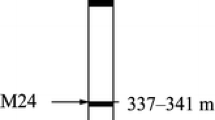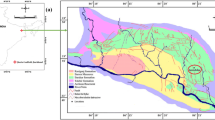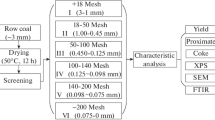Abstract
Physical separation of the organic and inorganic constituents in coal mostly depends on the degree of association and the manner of their distribution. The liberation of macerals and minerals in coal holds a vital role in the effectiveness of coal-washing technologies. The intent of the study is to observe the effect of particle size on the distribution of both macerals and minerals in coal. Different size fractions were generated, viz. −3350+1000μm, −1000+500μm, −500+212μm, −212+150μm, 150+75μm, 75+45μm and −45μm by using Indian standard sieves. Petrographic studies were carried out for all the size fractions to understand the distribution and the degree of liberation of macerals and minerals with respect to particle sizes. The results showed that the concentration of vitrinite gradually increases while inertinite and liptinite decrease with the decrease in particle size. Mineral matters decrease/increase with particle size depending upon the nature of associated minerals. Also, the particle size influences the type of mineral matter association depending upon their hardness.











Similar content being viewed by others
References
Arnold BJ, Aplan FF (1989) The hydrophobicity of coal macerals. Fuel 68:651–658
Banerjee A, Mishra PR, Mohanty A, Chakravarty K, Biswas RD, Sahu R, Chakravarty S (2016) Distribution of mineral species in different coal seams of Talcher coalfield and its transformation behavior at varying temperatures. Int J Coal Sci Technol 3(2):97–103
Barraza J, Piñeres J (2005) A pilot-scale flotation column to produce beneficiated coal fractions having high concentration of vitrinite maceral. Fuel 84(14–15):1879–1883
Bhatta R, Dash N, Nayak B (2021) Effect of heat on organic and inorganic components in some non-coking Lower Gondwana coals. Trans Indian Inst Met 74(2):387–397
Bureau of Indian Standard (BIS) (First revision of IS: 9127) (2002) Methods for the petrographic analysis of bituminous coal and anthracite (Part 3), Method of determining maceral group composition. Bureau of Indian Standard, New Delhi
Coal India Limited (1993) Coal atlas of India. Central Mine Planning & Design Institute Limited, Ranchi
Dyrkacz GR, Horwitz EP (1982) Separation of coal macerals. Fuel 61:3–12
Holuszko M, Kumar A, Kuppusamy VK, Engwayu J (2018) Investigation of the effect of particle size, petrographic composition, and rank on the flotation of Western Canadian coals. Int J Coal Prep Util. https://doi.org/10.1080/19392699.2018.1490277
Hower JC (1998) Interrelationship of coal grinding properties and coal petrology. Miner Metall Process 15(3):1–16
Hower JC, Calder JH (1997) Maceral/microlithotype analysis of the Hardgrove grindability of lithotypes front the Phalen coal bed, Cape Breton, Nova Scotia. Mining Metall Explor 14:49–54. https://doi.org/10.1007/BF03402751
Jayaweera SAA, Moss JH, Thwaites MW (1989) The effect of particle size on the combustion of Weardale Coal. Thermochim Acta 152:215–225
Jorjani E, Hower JC, Chelgani SC, Shirazi MA, Mesroghli S (2008) Studies of relationship between petrography and elemental analysis with grindability for Kentucky coals. Fuel 87:707–713
Jorjani E, Esmaeili S, Khorami MT (2013) The effect of particle size on coal maceral group’s separation using flotation. Fuel 114:10–15
Kok MV, Ozbas E, Karacan O, Hicyilmaz C (1998) Effect of particle size on coal pyrolysis. J Anal Appl Pyrolysis 45:103–110
Mija W, Tora B (2018) Development of dry coal gravity separation techniques. Mater Sci Eng 427. https://doi.org/10.1088/1757-899X/427/1/012003
Mishra V, Bhowmick T, Chakravarty S, Varma AK, Sharma M (2016) Influence of coal quality on combustion behaviour and mineral phases transformations. Fuel 186:443–455
Mishra V, Singh KN (2017) Microstructural relation of macerals with mineral matter in coals from Ib valley and Umaria, Son-Mahanadi basin, India. Int J Coal Sci Technol 4:191–197. https://doi.org/10.1007/s40789-017-0169-y
Misra SK, Pandya KL, Sahoo RK (2002) Petrographic study of non-coking coals from Talcher coalfield, Orissa and its significance in coal utilization. SGAT Bulletin 3(l):1–25
Nag D, Das B, Saxena VK (2016) Enhancement of coking properties of coal by differential screening. Int J Coal Prep Util 36(1):1–9. https://doi.org/10.1080/19392699.2015.1046597
O’Brien G, Firth B, Adair B (2011) The application of the coal grain analysis method to coal liberation studies. Int J Coal Prep Util 31(2):96–111. https://doi.org/10.1080/19392699.2010.537995
Polat M, Polat H, Chander S (2003) Physical and chemical interactions in coal flotation. Int J Miner Process 72:199–213
Raja Rao CS (1982) coalfields of India, coal resources of Tamil Nadu, Andhra Pradesh, Orissa and Maharashtra. Bull Geol Surv India 45(A):41–52
Reddy GV, Mahapatra SK (1999) Effect of coal particle size distribution on agglomerate formation in a fluidized bed combustor (FBC). Energy Convers Manag 40:447–458
Sahoo SK, Suresh N, Varma AK (2017) Studies on separation of macerals from coal by froth flotation. J Energy Nat Resour 6(3):38–44. https://doi.org/10.11648/j.jenr.20170603.12
Sahu L, Dey S (2017) Enrichment of carbon recovery of high ash coal fines using air fluidized vibratory deck separator. J Coal Sci Technol 4:262–273
Singh AK (2016) Petrographic and geochemical characterization of coal from Talcher coalfield, Mahanadi Basin, India. J Geol Soc India 87:525–534
Shu G, Zhang Y (2014) Research on the maceral characteristics of Shenhua coal and efficient and directional direct coal liquefaction technology. Int J Coal Sci Technol 1(1):46–55
Sokolovic J, Miskovic S (2018) The effect of particle size on coal flotation kinetics: a review. Physicochem Probl Miner Process 54(4):1172–1190
Stach E, Mackowski MT, Teichmüller M, Taylor GH, Chandra D, Teichmüller R (1982) Stach’s textbook of coal petrology, 3rd edn. Gebrüder Borntraeger, Berlin
Trimble AS, Hower JC (2000) Maceral/microlithotype analysis of the progressive grinding of a Central Appalachian high-volatile bituminous coal blend. Miner Metall Process 17(4):234–243
Trimble AS, Hower JC (2003) Studies of the relationship between coal petrology and grinding properties. Int J Coal Geol 54:253–260
Yu D, Xu M, Sui J, Liu X, Yu Y, Cao Q (2005) Effect of coal particle size on the proximate composition and combustion properties. Thermochim Acta 439:103–109
Zhang L, Hower JC, Liu W, Men D (2017) Maceral liberation and distribution of bituminous coal for predicting maceral-separation performance. Int J Coal Prep Util 37(5):237–251. https://doi.org/10.1080/19392699.2016.1160898
Acknowledgements
The authors are thankful to the Director, CSIR-IMMT, for permitting us to publish this paper. We express our sincere gratitude to Dr. B. Nayak for his guidance throughout the work. We are also thankful to Dr. B. K. Nayak and Dr. D. Satpathy of the Mineral Processing Department for extending their support in the analytical work.
Author information
Authors and Affiliations
Corresponding author
Ethics declarations
Conflict of interest
The authors declare no competing interests.
Additional information
Responsible Editor: Domenico M. Doronzo
Rights and permissions
Springer Nature or its licensor (e.g. a society or other partner) holds exclusive rights to this article under a publishing agreement with the author(s) or other rightsholder(s); author self-archiving of the accepted manuscript version of this article is solely governed by the terms of such publishing agreement and applicable law.
About this article
Cite this article
Bhatta, R., Dash, N. Influence of particle size on maceral and mineral distribution in Lower Gondwana coals of India. Arab J Geosci 16, 188 (2023). https://doi.org/10.1007/s12517-023-11286-4
Received:
Accepted:
Published:
DOI: https://doi.org/10.1007/s12517-023-11286-4




